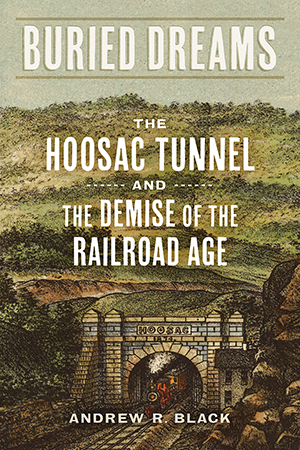
240 pages / 6.00 x 9.00 inches / 22 halftones, 1 line drawing, 2 maps
History / New England | Technology & Engineering / History | Transportation / Railroad History
The Hoosac railroad tunnel in the mountains of northwestern Massachusetts was a nineteenth-century engineering and construction marvel, on par with the Brooklyn Bridge, Transcontinental Railroad, and Erie Canal. The longest tunnel in the Western Hemisphere at the time (4.75 miles), it took nearly twenty-five years (1851‒1875), almost two hundred casualties, and tens of millions of dollars to build. Yet it failed to deliver on its grandiose promise of economic renewal for the commonwealth, and thus is little known today. Andrew R. Black’s Buried Dreams refreshes public memory of the project, explaining how a plan of such magnitude and cost came to be in the first place, what forces sustained its completion, and the factors that inhibited its success.
Black digs into the special case of Massachusetts, a state disadvantaged by nature and forced repeatedly to reinvent itself to succeed economically. The Hoosac Tunnel was just one of the state’s efforts in this cycle of decline and rejuvenation, though certainly the strangest. Black also explores the intense rivalry among Eastern Seaboard states for the spoils of western expansion in the post‒Erie Canal period. His study interweaves the lure of the West, the competition between Massachusetts and archrival New York, the railroad boom and collapse, and the shifting ground of state and national politics. The psychic makeup of Americans before and after the Civil War heavily influenced public perceptions of the tunnel; by the time it was finished, Black contends, the indomitable triumphalism that had given birth to the Hoosac had faded to skepticism and cynicism. Anticipated economic benefits never arrived, and Massachusetts eventually sold the tunnel for only a fraction of its cost to a private railroad company.
Buried Dreams tells a story of America’s reckoning with the perils of impractical idealism, the limits of technology to bend nature to its will, and grand endeavors untempered by humility.
Andrew R. Black has a PhD in history from Boston University. He is also the author of John Pendleton Kennedy: Early American Novelist, Whig Statesman, and Ardent Nationalist.
“This beautifully written book is social history at its best. By focusing on the trials and tribulations of an overambitious project that went awry, Andrew Black is also telling a much wider story that will resonate with similar ones across America. It is an example of how technological progress does not always realize the ambitions of its promoters and how big projects are not always the best solution to problems, something with which Massachusetts people will be particularly familiar.”—Christian Wolmar, author of The Great Railroad Revolution: The History of Trains in America
“History is about digging for connections, a job usually understood metaphorically, but in the case of Black’s account of the Hoosac Tunnel, a perfectly literal statement. His dramatic story of ‘The Great Bore,’ beautifully and painstakingly delivered, encompasses engineering genius, fatal miscalculation, and financial depletion in the railroad age. In a deeper sense, it’s a nineteenth-century morality tale of an almost operatic character. This highly readable book gives life to a world of dangerous enterprise, capturing the extended birth pangs of American modernity.”—Andrew Burstein, author of The Original Knickerbocker: The Life of Washington Irving
Found an Error? Tell us about it.